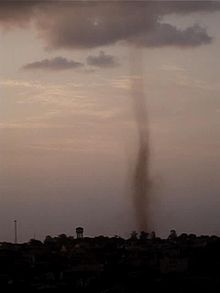




Landspout is a term created by atmospheric scientist Howard B. Bluestein in 1985 for a tornado not associated with a mesocyclone.[3] The Glossary of Meteorology defines a landspout:
Landspouts are typically weaker than mesocyclone-associated tornadoes spawned within supercell thunderstorms, in which the strongest tornadoes form.
Landspouts are a type of tornado that forms during the growth stage of a cumulus congestus or occasionally a cumulonimbus cloud when an updraft stretches boundary layer vorticity upward into a vertical axis and tightens it into a strong vortex. Landspouts can also occur due to interactions from outflow boundaries, as they can occasionally cause enhanced convergence and vorticity at the surface. These generally are smaller and weaker than supercell tornadoes and do not form from a mesocyclone or pre-existing rotation in the cloud. Because of this lower depth, smaller size, and weaker intensity, landspouts are rarely detected by Doppler weather radar (NWS).[5]
Landspouts share a strong resemblance and development process to that of waterspouts, usually taking the form of a translucent and highly laminar helical tube. "They are typically narrow, rope-like condensation funnels that form while the thunderstorm cloud is still growing and there is no rotating updraft", according to the National Weather Service.[2] Landspouts are considered tornadoes since a rapidly rotating column of air is in contact with both the surface and a cumuliform cloud. Not all landspouts are visible, and many are first sighted as debris swirling at the surface before eventually filling in with condensation and dust.
Orography can influence landspout (and even mesocyclone tornado) formation. A notable example is the propensity for landspout occurrence in the Denver Convergence Vorticity Zone (DCVZ).
Forming in relation to mesocyclones and under updrafts, a landspout generally lasts for less than 15 minutes; however, they can persist substantially longer, and produce significant damage. Landspouts tend to progress through recognizable stages of formation, maturation, and dissipation, and usually decay when a downdraft or significant precipitation (outflow) occur nearby. They may form in lines or groups of multiple landspouts.[6]
Landspouts are commonly weak; however, on rare occasions, a landspout can be as strong as an EF2orEF3 tornado.